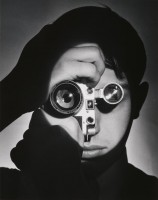ANDREAS FEININGER
أندرياس فاينينغر
安德烈亚斯·法宁格
안드레아스 파 이닝
アンドレアス·ファイニンガー
source: lavidaenfotografiawordpress
Andreas Feininger nasceu em Paris em 1906. Estudava arquitetura na Alemanha, mas acabou desistindo e foi para Suécia onde passou a se interessar pela fotografia. Antes da Segunda Guerra Mundial, Feininger mudou-se para os Estados Unidos e começou a trabalhar como freelance para revista Life
Feininger ficou famoso por suas fotografias de Nova York. Raramente fotografava pessoas, preferindo a natureza. Também foi autor de livros sobre técnicas fotográficas.
.
.
.
.
.
.
source: gallerym
Andreas Feininger combined an architect’s love of precision, space, and technique with an artist’s love of sweeping vistas. Although an American citizen, Feininger did not come to the United States until he was 33. Son of the late acclaimed artist Lyonel Feininger, he was born in Paris in 1906, and graduated with highest honors in architecture from schools in Germany. At the time, Feininger was using a camera as a reference aid in creating his building designs. The camera became his mechanical sketchbook.
Commissions were scarce for non-European citizens in the depressed economy. After a year’s work in France for the legendary architect Le Corbusier, followed by a struggle to find employment in Stockholm, Feininger turned his attention full-time to photography. He sold his first photos in 1932, moved with his family to the United States in 1939, and in 1943 became a staff photographer for LIFE magazine where he completed more than 430 assignments in a twenty year span.
Full of towering skyscrapers, broad swaths of road, and angles of geometric perfection, Feininger’s works are masterful in their technical excellence and panoramic grandeur. Such timeless images as New York Landscape Seen From Eight Miles Away in New Jersey, 1947 are notable for their harmony, balance, and grand scale. Through Feininger’s trained eye, the beauty and intricacies of both the natural and man-made world were magnified and intensified. From the broad span of bridges, exuding progress and power, to the symmetrical perfection of the skeleton of a carbon viper, Feininger’s images revealed a new aesthetic of order and geometric perfection. Even a seemingly utilitarian object like a doctor’s head mirror possesses mesmerizing, symbolic qualities when seen through Feininger’s lens.
Feininger had said that the city had attracted him since his earliest days as a photographer. But in time this love grew to include all the aspects of the city and its buildings, its people, its cars and traffic jams, its confusion and even its ugliness. I see the city as a living organism: dynamic, sometimes violent, and even brutal, he stated.
Also a prolific and admired writer, Feininger has published several textbooks and picture books on photography that are now translated into several languages.
.
.
.
.
.
.
.
source: fotostradaat
Der Sohn des Malers Lyonel Feininger machte zunächst eine Kunsttischler-Lehre am Bauhaus und eine Ausbildung zum Architekten in Zerbst, ehe er seiner Leidenschaft folgend Fotograf wurde. Seit seinen Aufsehen erregenden Reportagen für die Zeitschrift „Life“ gehört Feininger (1906-1999) zu den bedeutendsten Fotografen des 20. Jahrhunderts. Seine Aufnahmen aus dem New York der 40er Jahre sind Ikonen der Architekturfotografie. In der Retrospektive erweist sich Feininger darüber hinaus als großer Ästhet der Bildgestaltung, als genialer Naturbeobachter und als aufmerksamer Porträtist.
.
.
.
.
.
source: azizsakuranejp
パリでル・コルビジェに建築を学んだ経歴を持つファイニンガーは、1943年からLIFE誌のスタッフ・カメラマンとして活躍していました。このころの彼の写真には、彼の持つニューヨークへの愛着や希望などが如実に現れ、彼の取る写真は世界的にも評価されるようになりました。数多く撮影した50年代当時のニューヨークの写真は歴史的な資料としても収録され。短期間に大きく変貌した都市、ニューヨークを追うようにして、彼もまた進化していきました。


